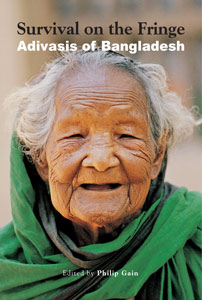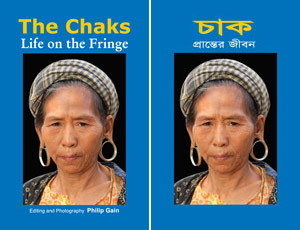
Survival on the Fringe: Adivasis of Bangladesh
A map of various Adivasi communities of Bangladesh, their life, rights, lands, the actors involved in their situation and recommendations.
2011, English, 630 pages, Hardback | Tk.1,500 / US$25
The book, compendium in nature, draws up a map of the Adivasis or small ethnic communities of Bangladesh—27 according to government and around 90 according to different sources. They are distinct and diverse in culture, language, tradition, religion, and history. Eleven of these Adivasi communities live in the Chittagong Hill Tracts (CHT) in the southeast, a territory with hill landscapes in sharp contrast with the rest of the country. The others live in the Northwest, North-central, Southeast and the coastal fringe of Bangladesh. Two of the ethnic communities—Garo or Mandi and Khasi are matriarchal; the others are patriarchal.
An introduction to the Adivasis of Bangladesh briefly discusses the geographical setting, disadvantages they are faced with, and their defense strategies. Profiles of major ethnic communities, brief descriptions of the little-known ones, a comprehensive list of them with numbers and their spatial distribution form a large part of the book that provides essential empirical information.
A very important section deals with the much talked about Adivasi issues such as the land, forests, access to commons, agricultural practices, invasion of monoculture on the public forestland affecting their life, culture, language, artefacts, identity, and political life.
A number of chapters provide insightful information and form a practical guide about resources on the Adivasis, the actors involved with them in Bangladesh and around the globe, glossary, theories, and concepts.
The facts, anecdotes, and analyses that this book brings together provide not only a map of the Adivasis of Bangladesh living on the fringe but also assists one to understand why their way of life, culture, tradition, history and education stand to be extremely valuable for Bangladesh.
One coherent message the book tries to communicate is that the majority of the Adivasi communities are among the most disadvantaged and socially excluded groups of Bangladesh. Many are historical victims on the fringe. The overwhelming Bangali majority society has a responsibility for their condition today. It is because of their craving for timber that their forests have been severely exhausted. It is because of their greed of land that they have lost what used to be their ancestral domains. It is they who have tried to impose their lifestyle on the smaller and little-known ethnic communities. Consequently, many Adivasis have been dislocated from their land, culture, and history.
In this context it is important that the state recognizes the Adivasis, put in place a legal framework, set mechanisms to pay special attention to them and pursue positive discrimination in favor of the extremely disadvantaged and excluded groups such as those in the tea gardens and on the extreme fringe. With this book in hand one will get some guidance and incentive to think and act differently about the Adivasi communities of Bangladesh.
Publication Details
Published: 2011
Language: English
Hardback: 630 pages
Editor: Philip Gain
Price: Tk.1,500 / US$25

